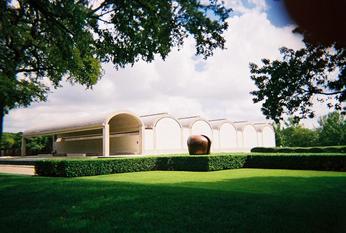I’m happy to report that I’m not the only one worried about what happens to permanent collections when museums build new buildings to show special exhibitions, solely or mainly. Lots of examples come to mind, including the Denver Art Museum, the High Museum in Atlanta, and — as I wrote in my last post — now the Kimbell Art Museum in Fort Worth.
 The problem is simple and obvious: visitors are drawn to the new buildings and the special exhibitions, and the permanent collection, sequestered in old digs, gets lost in the shuffle for attention.
The problem is simple and obvious: visitors are drawn to the new buildings and the special exhibitions, and the permanent collection, sequestered in old digs, gets lost in the shuffle for attention.
Jessica Brandrup, the Kimbell’s Head of Marketing and Public Relations, wrote to me after that post, and said the the Kimbell staff has given “a lot of thought” to the question “how to keep original museum buildings alive when new galleries open? … how can our landmark Louis Kahn building (above) remain a lively hub for the appreciation of art once the museum facility by Renzo Piano opens across the way?”
So, a bit contrary to the generalizations in the press release and articles about the plans for a Renzo Piano building/addition, Brandrup says this:
In fact, we will often exhibit portions of the permanent collection in the Renzo Piano building. For instance, the Asian Collection, with its many light sensitive scrolls, will be especially well suited for the southwestern gallery of the new building, which has no natural light. (When the Asian Collection is exhibited in the Kahn building, we have to block out all of the natural light, which detracts from Kahn’s architecture.) Likewise, we will occasionally feature special exhibitions in the Kahn building.
I’ve already mentioned that the stairs/escalators from the parking garage are positioned so that visitors come up facing the Kahn building — though the Piano building is closer — but Brandrup adds another feature:
we are intending to keep a number of our most popular visitor amenities (such as our restaurant and museum store) in the Kahn building.
Fine, but the Piano building, according to the press release, will also house “a cafe, exhibition store, and coat-check.”
I’m not playing gotcha here, and I appreciate Brandrup’s email, with the additional information. At least the Kimbell is thinking about such matters. It’s still something of a problem for several museums. The Piano building won’t be open for a few years, but it will be interesting to watch what happens in Fort Worth.
